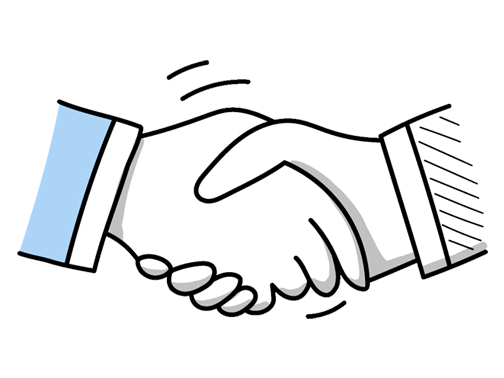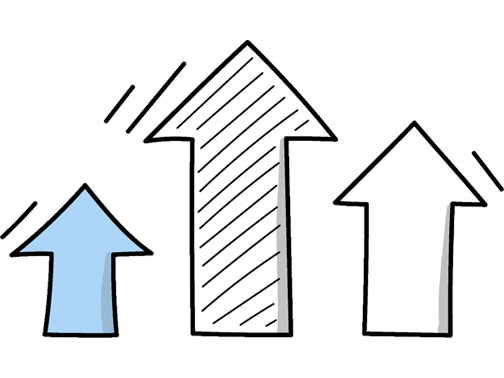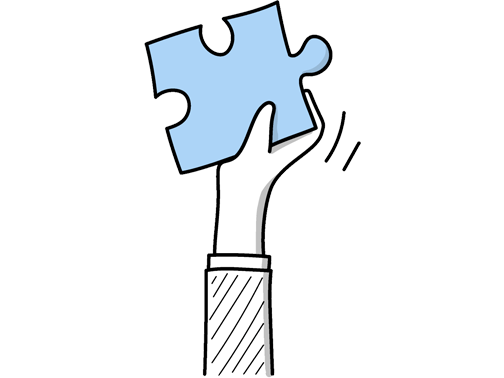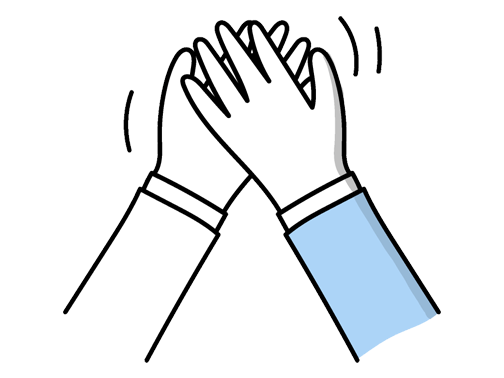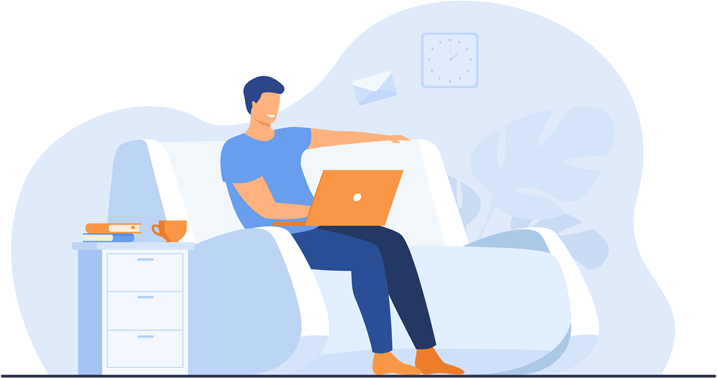Graphic Design Assistant Interview Questions (2025 Guide)
Find out common Graphic Design Assistant questions, how to answer, and tips for your next job interview
Practice Interviews Online - Identify your strengths and weakness in a realistic Graphic Design Assistant mock interview, under 10 minutes
Practice Now »Graphic Design Assistant Interview Questions
Interviewers ask this to understand how you approach problem-solving and manage projects from start to finish. You need to explain your steps clearly, like researching, sketching ideas, getting feedback, and refining your design until it meets the goal.
Example: Sure! I usually start by understanding the brief and gathering inspiration. Then, I sketch ideas to explore different directions. Once I find a concept that clicks, I develop it digitally, paying attention to details and brand consistency. I also like to get feedback along the way to refine the design. For example, in a recent project, early input helped me adjust colours to better connect with the target audience.
What they want to know is how you manage teamwork challenges calmly and constructively. You should say you listen carefully to others' views, stay calm, and work together to find a fair compromise.
Example: When conflicts arise, I make a point to really listen to everyone’s views before responding. I find that keeping a calm and respectful attitude helps create a space where we can brainstorm solutions together. In a previous project, this approach helped us turn a disagreement over design direction into a fresh idea everyone felt good about. Staying focused on the goal rather than the problem usually leads to a positive outcome.
Interviewers ask this question to see how you manage creativity while meeting specific client needs. You need to explain how you adapted your ideas to satisfy client goals without sacrificing design quality.
Example: In a recent project, I designed branding materials for a local café. The client wanted a fresh, modern look but also needed to keep their established colours. I focused on creating clean layouts and playful typography that respected their palette while giving a vibrant feel. It was rewarding to see how balancing their vision with creative touches made the brand come alive, pleasing both them and their customers.
What they want to know is if you are proactive about learning and adapting to new tools, which is crucial in a fast-evolving field like graphic design. You should say that you regularly follow design blogs, take online courses, and experiment with new software to stay current and improve your skills.
Example: I keep up with design trends by regularly exploring industry blogs and websites like Creative Bloq and Adobe’s updates. I also follow a few talented designers on social media to see what tools they’re using. When possible, I experiment with new software features myself, which helps me learn quickly and stay comfortable with emerging technologies. This way, I can bring fresh ideas and skills to the team.
This question assesses your problem-solving skills and familiarity with design software. You need to show that you stay calm, methodically identify the issue, and use resources like tutorials or support forums to resolve problems efficiently.
Example: When I encounter technical issues in design software, I stay calm and start by identifying the problem clearly. I usually check for updates or search for quick solutions online. For example, once I fixed a layering glitch in Photoshop by resetting preferences, which saved me time. If needed, I reach out to colleagues or forums. Staying patient and methodical helps me get back on track smoothly.
This interview question helps the employer understand your practical experience and how you handle real-world design challenges. You need to clearly describe specific projects you worked on, your role in them, and any challenges you overcame to show your skills and problem-solving abilities.
Example: I’ve worked on a variety of projects, from designing social media graphics for local businesses to creating promotional materials for community events. In one project, I helped revamp a charity’s newsletter, focusing on clear layouts and engaging visuals. It was a bit challenging balancing brand guidelines with creative flair, but by collaborating closely with the team, we found a good mix that really resonated.
Questions like this assess your teamwork and communication skills, which are essential in a collaborative design environment. In your answer, briefly describe how you clearly shared your ideas, coordinated with others to meet shared goals, and adapted your work based on feedback.
Example: In a recent project, I worked closely with both the marketing and content teams to create a campaign. We regularly shared ideas and gave feedback, which helped us align our vision. I stayed open to suggestions, adjusting designs to fit different media formats. This collaboration not only improved the final product but also strengthened our teamwork, making the process more efficient and enjoyable for everyone involved.
What they want to know is how confident and skilled you are with essential Adobe tools and how you apply them in real projects to stay organized and efficient. You should clearly state your experience with Photoshop, Illustrator, and InDesign, giving examples of tasks like image editing and using layers or artboards to manage your work effectively.
Example: I’ve spent a lot of time working with Photoshop, Illustrator, and InDesign, creating everything from social media graphics to brochures. I’m comfortable organizing files and assets to keep projects running smoothly. When new features roll out, I make it a point to explore them quickly, which has helped me improve efficiency and stay current with design trends. For example, I recently used Illustrator’s new vector tools to streamline a logo redesign.
This interview question assesses your problem-solving skills and creativity under pressure. You need to describe a specific project, the challenge you faced, and the clear steps you took to successfully resolve it.
Example: In a recent project, I had to create a brand identity with a very tight deadline and limited resources. I focused on simplifying the design process by prioritizing essential elements and communicating closely with the client to ensure their vision was clear. This approach helped me deliver a clean, effective design on time, proving that clear communication and flexibility are key when challenges arise.
Questions like this help interviewers see how you handle stress and problem-solving in real work situations. In your answer, clearly describe a specific design challenge with a tight deadline, explain your quick and creative solution, and show how you stayed calm to deliver quality work on time.
Example: During a tight deadline for a client’s rebranding project, the original logo files were corrupted. I quickly recreated the design from memory, adapting elements to improve clarity. Staying focused helped me deliver a polished result on time, which the client appreciated. It taught me the importance of staying calm and resourceful when unexpected issues arise, ensuring the quality doesn’t slip even under pressure.
Questions like this assess your ability to stay organized and manage time effectively when juggling multiple projects. You need to explain that you prioritize tasks by deadlines and importance, use tools like calendars or project management software to stay organized, and communicate progress regularly to ensure smooth workflow.
Example: When managing several design projects, I start by mapping out deadlines and key milestones, so I know what needs attention first. I keep an open line of communication with the team to update progress and address any shifts in priorities. If something urgent comes up, I’m flexible enough to adjust my schedule without losing sight of the bigger picture. For example, balancing client briefs and internal materials taught me to stay organized and responsive.
What they want to know is how skilled you are with key design tools and your ability to learn new ones quickly to enhance your work. You should mention your experience with Adobe Photoshop and Illustrator, give examples of adapting to new software under pressure, and explain how these skills improved your design quality or efficiency.
Example: I’m most comfortable working with Adobe Creative Suite, especially Photoshop and Illustrator, which I use regularly for both digital and print projects. I’ve also picked up skills in InDesign for layout work. That said, I’m quick to learn new tools when the project calls for it—recently, I adapted to using Figma to collaborate more effectively with web teams. Ultimately, I see software as a means to bring creative ideas to life efficiently.
This question assesses your creativity and problem-solving skills in real work situations. You need to describe a specific project where you identified a challenge and used an unconventional idea or approach to overcome it successfully.
Example: During a recent project, we needed to create eye-catching visuals on a tight budget. Instead of relying on expensive stock images, I experimented with simple illustrations and bold color blocking to convey the message effectively. This approach not only saved costs but also gave the design a unique, fresh feel that resonated well with the audience. It was a good reminder that sometimes creativity thrives with fewer resources.
Employers ask this question to see how well you handle criticism and work collaboratively to improve your designs. You should say that you listen carefully, ask clarifying questions to fully understand the feedback, and then adjust your design accordingly while maintaining clear communication with your team.
Example: When I receive feedback, I make sure to fully understand the points being made by asking questions if needed. I view it as a chance to improve the design, so I carefully consider which suggestions enhance the overall message. For example, in a past project, adjusting colours based on client input helped better capture their brand’s personality. I see feedback as part of a teamwork process that strengthens the final product.
What they want to know is how you find creative ideas and stay inspired, showing your resourcefulness and passion. You should say you explore various sources like nature, art, and current design trends to fuel your creativity and keep your work fresh.
Example: I usually start by exploring a mix of sources like design blogs, social media, and even everyday surroundings to spark ideas. I also look at work from different industries to see fresh approaches. For example, a recent project was inspired by street art I saw while commuting, which helped me bring a unique edge to the concept. Drawing from varied experiences keeps my work creative and relevant.
Interviewers ask this to see if you understand the importance of aligning your work with the client’s goals. You need to say that you communicate clearly with the client, ask questions to clarify their vision, and review your designs regularly to make sure they match the objectives.
Example: When starting a project, I listen carefully to the client to understand their vision and goals. I maintain open communication throughout, sharing drafts and gathering feedback to make sure the design aligns with their expectations. For example, in a recent project, frequent check-ins helped me catch small changes early, resulting in a final design the client was really happy with. This approach keeps the work on track and builds trust.
Hiring managers ask this question to see your creativity, technical skills, and passion for design. Choose a piece that highlights your strengths and explain how it showcases your growth or problem-solving abilities.
Example: One piece I’m proud of is a rebranding project for a local charity. I created approachable, vibrant visuals that helped modernise their image and connect better with younger supporters. Seeing how the new design boosted their social media engagement made me realise how effective thoughtful design can be in driving real impact—and that’s something I’d love to bring to this role.
Employers ask this to see how you collaborate and contribute within a team. You need to say whether you take on a leadership, supportive, or creative role, and give a brief example of how you help the team succeed.
Example: In team settings, I usually take on a collaborative role, focusing on listening and contributing ideas thoughtfully. I enjoy supporting others by handling detailed tasks, like refining designs or organising files, which helps the project run smoothly. For example, during a group project at university, I coordinated feedback, ensuring everyone’s input was considered and we met deadlines comfortably. I find that balancing creativity with structure benefits the whole team.
This interview question aims to assess your familiarity with web design tools relevant to the graphic design role. You need to clearly mention the specific tools you’ve used and briefly explain how you applied them in your work.
Example: Yes, I’ve had experience with web design tools such as Adobe XD and Figma. I’ve used them to create wireframes and simple prototypes for website layouts. These tools help streamline the design process and improve collaboration, especially when working with developers or clients. It’s been valuable in understanding how design adapts to user interaction and overall web functionality.
This interview question helps assess your ability to receive and use feedback effectively, which is crucial in collaborative design work. You should explain that you listen carefully to understand the feedback, ask clarifying questions, and adapt your designs accordingly to improve the final product.
Example: I see feedback as a valuable part of the creative process. When a client or teammate offers suggestions, I listen carefully and ask questions if anything isn’t clear. It helps me understand their vision better and improve the design. For example, in my last role, adjusting a project based on client input led to a final piece everyone was happy with, which felt really rewarding.
Employers ask this to see if you can manage pressure and prioritize tasks effectively. You need to explain a specific example where you stayed organized, focused, and communicated clearly to meet a deadline successfully.
Example: Yes, I've worked under tight deadlines several times, especially during busy project periods. I prioritize tasks, stay organized, and keep communication clear with the team. For example, once I had to redesign a brochure last minute for a client meeting. By breaking the work into manageable steps and focusing on key elements, I delivered a polished design on time without compromising quality.
Interviewers ask this question to see if you can create flexible designs that work well on various devices and platforms, ensuring a consistent user experience. You need to explain how you use responsive design principles, adapt to platform-specific requirements like file formats, and utilize tools that preview designs across different devices.
Example: When designing, I focus on creating flexible layouts that look great on various screen sizes and resolutions. I also pay attention to each platform’s unique guidelines to make sure visuals work smoothly whether it’s on mobile, desktop, or social media. I often use tools like responsive grids and preview features to test how designs adapt, ensuring the final product feels consistent and polished everywhere it appears.
Hiring managers ask this to see if you can accept constructive criticism and work well with others. You need to say you listen carefully, ask questions if feedback is unclear, and explain how you adapt your design by incorporating changes collaboratively.
Example: When I receive feedback that calls for major changes, I take it as an opportunity to improve the design. I listen carefully to understand the reasoning behind it, then adjust my work accordingly. For example, in a past project, shifting the colour scheme based on client input really strengthened the overall impact. I find staying open and communicating clearly helps keep the process positive and collaborative.
This question helps assess your ability to collaborate and keep projects on track. You need to say you prioritize clear, open communication by regularly sharing updates and actively listening to team members’ ideas and feedback.
Example: To ensure smooth communication in a design team, I focus on being clear and open. I make a point to listen actively and share ideas early, which helps avoid misunderstandings. Using tools like shared drives or messaging apps keeps everyone updated. For example, in a previous project, regular check-ins helped us stay aligned and catch issues before they became problems.
This interview question helps the employer understand how you stay productive and creative under pressure. You need to say you take breaks to refresh yourself, try different design techniques, and stay persistent to meet deadlines despite challenges.
Example: When I hit a creative block, I usually step away for a bit—sometimes a short walk or switching to a different task helps clear my mind. I also look for inspiration around me, like browsing design blogs or revisiting past projects. It’s important to stay curious and be flexible; often, a fresh perspective leads to new ideas and keeps the momentum going until the right solution appears.
Ace your next Graphic Design Assistant interview with even more questions and answers
Common Interview Questions To Expect
The interviewer is looking for a brief overview of your background, experience, skills, and career goals. Focus on relevant information related to the job and company.
Example: Sure! I recently graduated with a degree in graphic design and have been working on building my portfolio. I have experience with Adobe Creative Suite and a passion for creating visually appealing designs. I'm excited to continue learning and growing in the field of graphic design.
The interviewer is looking for a candidate to demonstrate their skills, experience, passion for the role, and how they can contribute to the company. Candidates can answer by highlighting their relevant experience, creativity, attention to detail, and ability to work well in a team.
Example: You should hire me for this position because I have a strong background in graphic design, with experience working on various projects. I am passionate about creating visually appealing designs and pay close attention to detail. I also work well in a team and can contribute positively to the company's goals.
The interviewer is looking for examples of how you have collaborated with others, communicated effectively, and contributed to team goals. Be prepared to discuss specific projects and your role within the team.
Example: Sure! In my previous role as a Graphic Design Assistant, I worked closely with a team of designers to create marketing materials for a variety of clients. I communicated regularly with team members to ensure our designs were cohesive and met the client's needs. Together, we successfully completed projects on time and exceeded client expectations.
Interviewees can answer by discussing a specific mistake, acknowledging responsibility, explaining how they rectified the situation, and highlighting lessons learned. Interviewers are looking for honesty, accountability, problem-solving skills, and the ability to learn from mistakes.
Example: Yes, I once accidentally sent a design file to the wrong client. I immediately owned up to my mistake, apologized to the client, and quickly sent the correct file. I learned the importance of double-checking recipient information before sending any work.
The interviewer is looking for your level of interest in the company and the role, as well as your curiosity and preparedness. You can ask about company culture, team dynamics, or future projects.
Example: Yes, I was wondering about the team dynamics in the graphic design department. How do team members typically collaborate on projects? Also, could you tell me more about any upcoming projects the team will be working on?
Company Research Tips
The company's website is a goldmine of information. Look for details about the company's history, mission, values, and culture. Pay special attention to their portfolio or case studies section to understand the kind of graphic design work they do. This will give you an idea of their design style, the industries they work with, and the type of clients they serve.
Tip: Don't just skim through the website. Take notes and think about how your skills and experiences align with the company's work.
Social media platforms can provide insights into the company's current projects, events, and overall brand image. Platforms like LinkedIn can give you information about the company's size, location, and employee roles. Instagram, Facebook, and Twitter can show you their latest work, how they interact with customers, and the tone of their communication.
Tip: Look for any recent news or posts related to the graphic design department. This can give you talking points during the interview.
Understanding the company's competitors can give you a broader view of the industry and the company's position within it. Look at the competitors' design work, their strengths, and weaknesses. This can help you understand what sets your prospective employer apart and how you can contribute to their success.
Tip: Use this information to show your understanding of the industry and to suggest how you could bring new ideas to the table.
Websites like Glassdoor provide reviews from current and former employees. These reviews can give you a sense of the company culture, work environment, and management style. Remember, take these reviews with a grain of salt as they are subjective and may not represent the overall experience.
Tip: Look for common themes in reviews. If many people mention a specific positive or negative, it's likely to be a part of the company culture.
What to wear to an Graphic Design Assistant interview
- Smart casual attire
- Clean, well-fitted jeans
- Button-down shirt or blouse
- Blazer or cardigan for layering
- Comfortable, polished shoes
- Minimal, professional accessories
- Avoid overly bright colors
- Ensure clothes are ironed
- Avoid wearing too much perfume
- Carry a portfolio of your work
